It’s hard to believe that the Ford Fiesta is on its 8th generation. But back in the 70’s it was the new kid on the block as the smallest when it was introduced as the smallest car on the new Ford range, smaller than the Ford Escort, Cortina and Granada it was also Fords first move to front wheel drive back in the day.
Today the latest generation Fiesta is the longest established brand name in the Ford range and it is still pushing out the boundaries.
Familiar Ford Face.
Over the last few years I have watched the knew face (headlights and grill) develop on the Ford range, First to run with it was the Ford Mondeo. When it arrived out first I thought it looked more like the front of one of the new Ferrari. But now as this new Ford Fiesta comes on stream. I am thinking that the new face of the Ford has similarities to an old Ford of yesteryear.
This new Fiesta that we had a short run in this week especially this model with the mesh type grill looks a bot like a version of the old Ford Anglia,
Big petrol drive.
The new Fiesta have a big range of petrol engines at different power ranges but all under 1,000cc
This is the new way forward in motoring as the cars makers start slowly from diesel power. For Fiesta owners from the past this is not as big a change over as in other makes as they was always a good percentage of petrol version sold along with the diesel version over the years. The car we drove was a 75bhp one litre(or just under 1,000 cc) At the start it was hard to tell it was diesel or petrol as both engines are so quiet now-a-days. but when you push the car on you can hear the latest of three cylinder turbo boost petrol engines.
In 2018 I hope to have a longer test drive in this new Fiesta and drive it for a longer time to see how easy it is on petrol compared to a diesel power car of the same size. First impressions are good though on this mini road trip, but being used to driving diesel car over the years it the torque that I miss on a petrol car compared to a diesel. This is more down to my driving style than anything else.
The car I drove was near enough the base model but had all the extras you would expect for the coming year of 2018, One big one for me was the amount of power outlets around the dash which is a must for the demands of the present world of phones and games and tablets.
All in all the car felt great on the road and probably has more room inside it for the driver than the Ford Cortina had inside it when it was in vogue in the 60’s, 70’s, and early 80’s. This latest generation of the Ford Fiesta offer a lot in style and road presence. and even after this short drive in the car I would have no bother recommending the car. I look forward to doing a more in-depth test of this new generation car in the new year.
The affluent Ballymacool!
Having proud connections in the area I know a lot of people, past and present who would be tickled pink by the results of the most recent census, which singles out Ballymacool as more affluent than average! Mind you there was a time when that status could have been more than well deserved.
Back in 1901 on the night the census form was filled out, Mary Rosalie Boyd at just 20 years of age was recorded as head of her family in Ballymacool House.
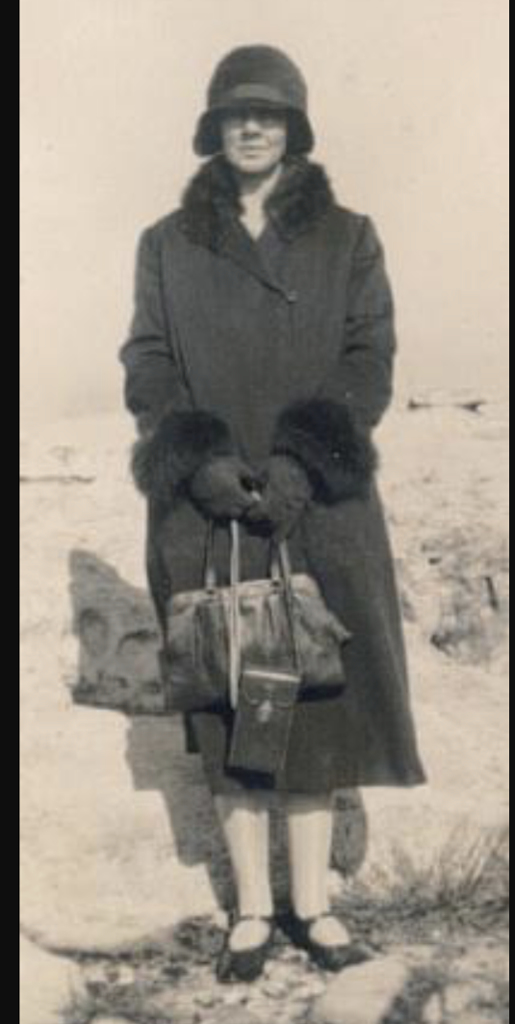
Award winning writer and poet, Mary Rosalie Boyd born in Ballymacool House 1880 who enjoyed a cuppa and a chat at the Doherty gatehouse in Ballymacool.
There were 40 rooms in her house which housed 11 people including her brother and sister, Helen, 18, Agnes 11, Haidee 9 and Charles 8. Also living there was their governess, Hedvig, Holmgrist from Lithuania, Hannah Saunders was their cook, Mary Ellen Crone was the Parlour Maid, Sarah McCormack and Mary Keogh were both housemaids and domestic servants.
Class or Glass!
Ballymacool House was considered a first-class house in the 1901 census as it had 14 windows in the front of it. The only other house in the townland of Ballymacool to be classed as a first class house was that of Richard Collins with eight front facing windows. Ballymacool House also had 32 out-offices and sheds recorded that year.
Second class
In the Outer Gatehouse of Ballymacool House in 1901, described on the map as “The Lodge” it had 4 windows in the front of it, naturally enough! Not for the benefit of letting in God’s light but to make sure that tenants would see the people of the big house arriving and leaving up and down the avenue and get the gates opened.
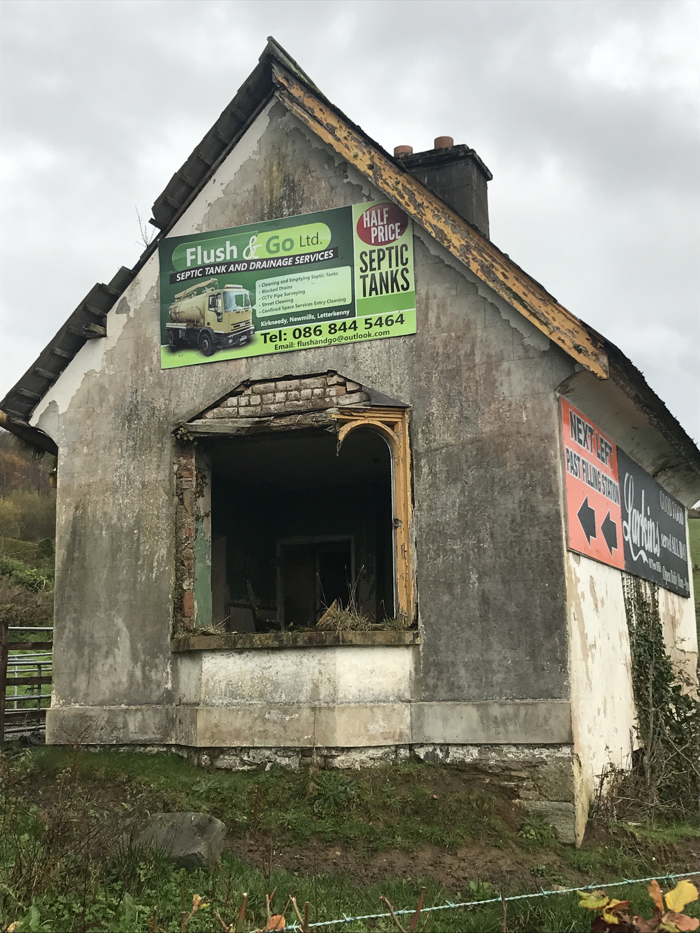
The Gatehouse in Ballymacool, home to the Doherty family in 1911. Photo Brian McDaid
Because of the glass in the gatehouse, the house was classed as a second class house even though it only had two bedrooms. In that house in 1901 lived a family of nine.
The head of that family was John Doherty and his wife Bridget, sons and daughters, Hugh, Ellen, Bridget, Cassie, Annie, Bella, and Maggie. John Doherty’s profession was described as a garden laborer. His older children were described as scholars down as far as Bridget and Cassie, 7 and 4, who came under the heading “can read only”! The 7-year-old Bridget Doherty in 1901 was my grandmother.
Packed to the rafters
Then years later, when the 1911 census was taken in the townland of Ballymacool there was 11 living in the outer gatehouse in Ballymacool.
There was only three of the Boyd family living in the Ballymacool, William Henry Boyd, head of house, his wife Charlotte and their daughter Elizabeth, they had four house staff, Cook, Mary Mc Elhinney, Sara Jane Garrow, Parlour Maid, Elizabeth Mc Givern, Housemaid and Annis Elizabeth Gailey between maid/ servant.
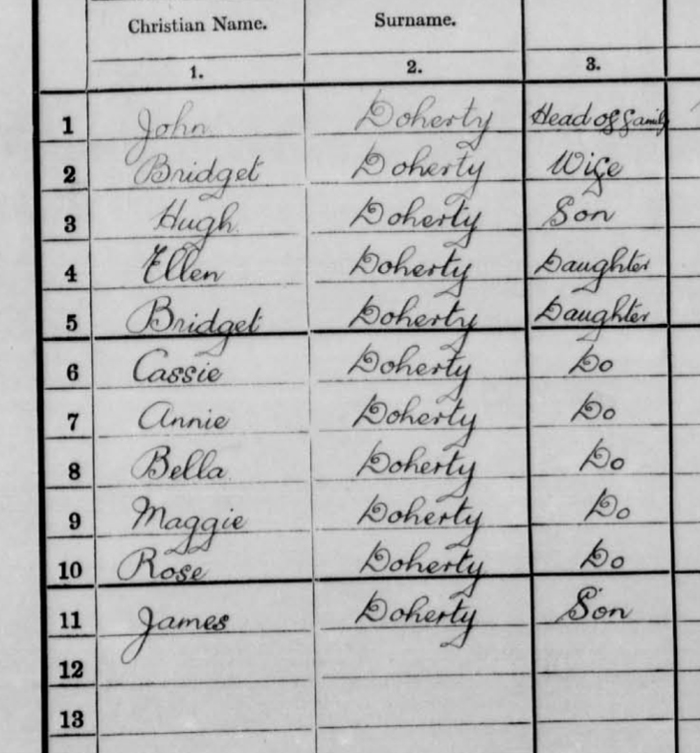
The census form fill out by the the Doherty’s from gatehouse in 1911, where 11 of them lived in a two-bed room house. Photo Brian McDaid
Meanwhile down the avenue the Gatehouse or Lodge where they Doherty family had two new additions to the family Rose and James now 10 and 8 which brought the total number of Dohertys living in the gatehouse to 11, with the oldest son, Hugh (24) down through the seven daughters, Ellen 21, Bridget 17, Cassie 14, Annie 12, Bella 11, Maggie 10, Rose 8, and James 4.
High Tea
If Mrs. Doherty hadn’t enough bother at the gatehouse trying to make room for her own family, she also had to make room for special visitors on occasion!
The year of the 1911 census Mary Rosalie, daughter of William Henry Boyd, was on the way to South Africa now an MA graduate of London University, now called Mary Rosalie Treharne Boyd and settled in Port Elizabeth.
She won three “Bardic Chairs” for her poetry, South Africa’s highest literary award. The poems for which these awards were given were “The Veldt” (1921), “Drought” (1930) and “Table Mountain” (1931).
On her visits home to Ireland she always tried to include a trip up to Donegal. And when she was there she retraced her footsteps as a child growing up in Ballymacool.
I only know this thanks to the late May McClintock who discovered a passage from her book or memoir from Mary Rosalie Boyd. She wrote about having afternoon tea in Ballymacool down at the far away gatehouse with Mrs. Bridget Doherty enjoying a long chat with her about her family.
On her very last visit to Mrs Doherty’s home Mary Rosalie recalled that Mrs Doherty had been ill and was confined to bed but insisted on getting up for her visit. Mrs. Doherty’s daughter. Maggie was the only one of the children still living in the house with her along with her husband John.
New Beginnings
In 1916 Bridget and John Doherty’s second oldest girl, also Bridget (my Granny) got married to Willie Coyle and got a house in Ballymacool Terrace, first in No 1 but they were to move further up the row to number 19. One possible reason for this may have been at the request of Charlotte Boyd from Ballymacool House.
Charlotte Boyd was a big activist through World War 1 in rehousing Belgian refugees in Letterkenny some of the war-stricken families were moved into Ballymacool Terrace for the duration of World War 1.
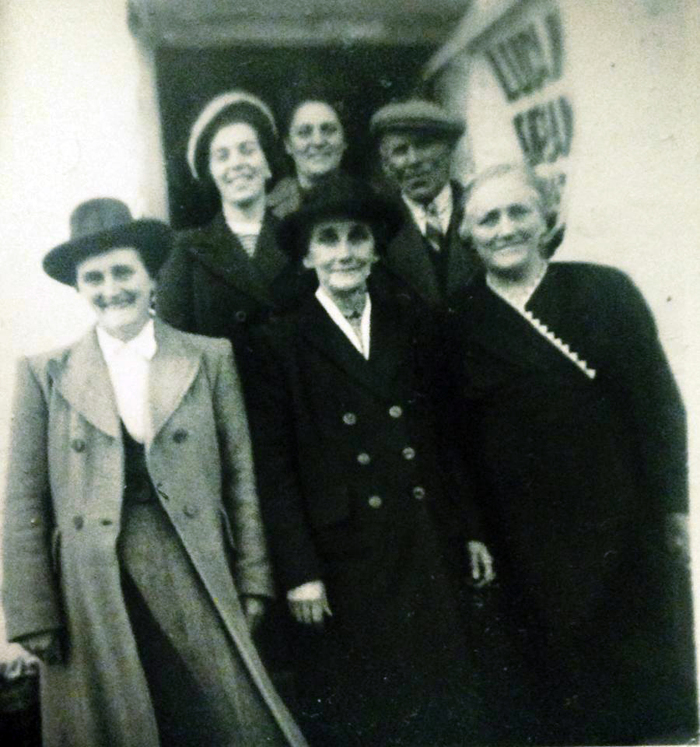
Bridget Coyle (Nee Doherty) and some of her sister , Annie and Ellen , (possibly) from the gatehouse in Ballymacool pictured at her shop which now belongs to Kernans at the foot of the town.
Bridget and Willie Coyle rared a family of 10 children at No 19 Ballymacool Terrace including Charlie, Bida, Willie, Roselene, Johnny, Mary Ellen, Neilus, Catherine, Hugo and Margaret. Her daughter Bida (Deeney) often recalled regular trips out to visit Granny Doherty at the outer gatehouse and also getting invited by the Boyds up to the big house in Ballymacool around Christmas time.
WindFall
In the latest census Ballymacool has come out in a classification of being affluent on paper anyway but it wasn’t always the case. In years gone by when times were tough the children in nearby Ballymacool Terrace went out following a big storm with prams and gathered the fallen timber from the big trees up the avenue of Ballymacool House.
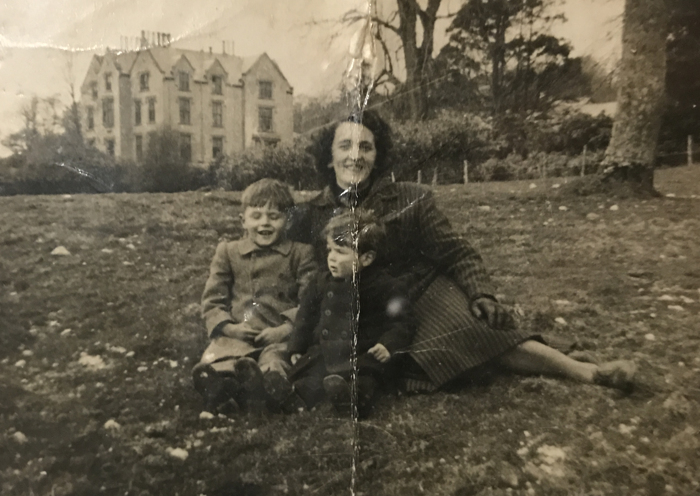
Mary Ellen Coyle, granddaughter of John and Bridget Doherty from the outer gate house, pictured with her two nephews Seamus and Billy Gill, (Now in Australia) sitting on the lawn outside Ballymacool House in the 1950’s
That was their fuel for the winter along with “shows” the waste wood from the nearby mill.
Today both the gatehouse and Ballymacool House are still there but sadly no one lives in them anymore only the memories of a forgotten past.
Happy Motoring Folks
Tags:







